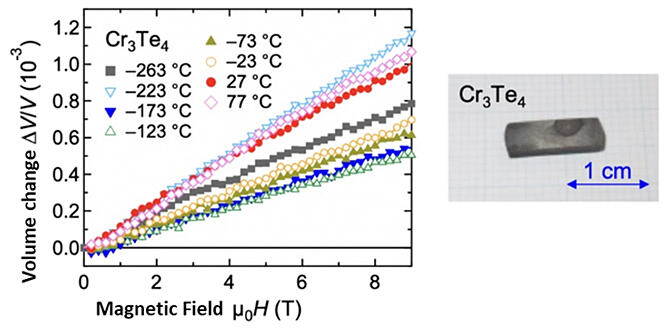A research group led by Professor Yoshihiko Okamoto of The Institute For Solid State Physics at The University of Tokyo, graduate students Yuki Kubota and Tomoya Kanematsu (at the time of the research), Associate Professor Daigorou Hirai and Professor Koshi Takenaka of the Department of Applied Physics, Nagoya University, in collaboration with Research Associate Takeshi Yajima of the Institute for Solid State Physics, has discovered a new material that expands in volume significantly when a magnetic field is applied over a wide temperature range, including room temperature.

Provided by ISSP, UTokyo
The research group found that chromium telluride sintered bodies of Cr3Te4 and Cr2Te3 composed of chromium (Cr) and tellurium (Te) exhibit magnetic field‐induced strain (magnetostriction) accompanied by large volume expansion. In particular, when a magnetic field of 9 T is applied, Cr3Te4 exhibited a large volume expansion over a wide temperature range from ‐260℃ to 80℃, with a maximum volume expansion of 1,200 ppm. Such huge volume changes in magnetic fields are limited to Invar alloys, which are well‐known thermal expansion control materials, indicating that these chromium tellurides are promising as new actuator materials.
This volume expansion in a magnetic field also has various features that differentiate it from conventional magnetostrictive materials. Unlike conventional magnetostriction, where the shape of the object mainly changes and the volume does not change significantly, the volume changes significantly while retaining its shape in a magnetic field. It also shows a volume expansion almost proportional to the magnetic field over a wide range of magnetic fields from zero to at least 9 T.
These results indicate that the magnetostriction in the discovered chromium tellurides is not due to the alignment of ferromagnetic domains by the magnetic field as in conventional magnetostrictive materials. Examination based on the experimental results of magnetostriction, thermal expansion, low‐temperature X‐ray diffraction and magnetization of Cr3Te4 and Cr2Te3 revealed that magnetostriction with large volume expansion is most likely caused by the effect of anisotropic deformation of the crystal lattice due to the magnetic field in concert with the effect of the material structure, which changes the size of voids present in the sintered sample. This is a new mechanism that realizes magnetostriction with large volume changes.
"The characteristic of volume expansion almost in proportion to the magnetic field over a wide range of magnetic fields opens up new applications that are not possible with existing magnetostrictive materials, such as fine particles whose volume can be controlled in a non‐contact manner," explained Okamoto. "It is also important to note that the new mechanism has achieved enormous volume expansion due to the magnetic field in a material system that is completely different from conventional magnetostrictive materials, and we hope to realize further high‐performance magnetostrictive materials and unprecedented functions that correlate magnetism and volume in magnetic compounds that contain chromium."
■ Magnetic field‐induced volume change (magnetostriction): A phenomenon in which the shape and size of an object changes in a magnetic field. It commonly occurs in ferromagnetic materials. In normal ferromagnetic materials, the magnitude of magnetostriction is around 1 to 10 ppm, but some alloys of iron and rare earth metals exhibit magnetostriction in excess of 1,000 ppm.
This article has been translated by JST with permission from The Science News Ltd. (https://sci-news.co.jp/). Unauthorized reproduction of the article and photographs is prohibited.




